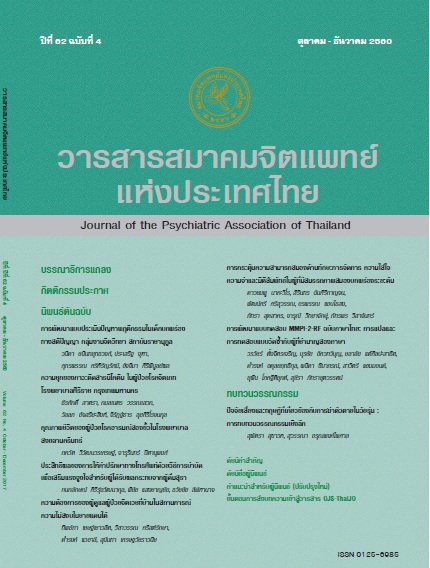การประเมินคัดกรองภาวะเพ้อหลังผ่าตัดด้วยเครื่องมือ 4 'A' Test ฉบับภาษาไทย ในผู้ป่วยสูงอายุที่เปลี่ยนข้อสะโพกหรือข้อเข่า
Main Article Content
Abstract
Objective : To assess effects of postoperative delirium screening using the Thai-Version
4 ‘A’s Test (4AT-T) and survey users’ opinions on using this instrument.
Methods : Sixty-nine elderly inpatients receiving hip/knee arthroplasty were enrolled
to undergo postoperative delirium screening with the 4AT-T. Patients screened
positive were re-evaluated by a psychiatrist to confirm diagnosis based on DSM-5. The
percentage of confirmed delirium cases, length of hospital stay (LOS) and mortality
rate were collected and compared with historical control data of elderly inpatients
(n = 154) receiving the same operations during the pre-implementation period, which
were reviewed from medical records. After all the screening process, 30 experienced
nurses were surveyed for their opinion of the 4AT-T by questionnaire.
Results : The percentage of patients with delirium in the screening group was 1.3%,
comparable to 1.4% in the control group (P = 1.00). Mortality rates in both groups were
zero. The LOS (in hours) of the control group (Median = 67; Interquartile range, IQR =
23) was greater than that of the screening group (Median = 52; IQR = 25) (P = .023).
Eighty percent of the nurses agreed that the screening is easy and simple. They were
satisfied to use this instrument. However, 33.3% and 26.7% considered it to increase
excessive workloads and time-consuming, respectively.
Conclusion : The postoperative delirium screening by the 4AT-T revealed low prevalence
of delirium in this study. However, most users were satisfied to use this instrument despite
some concerns about impacts on their workload.
Article Details
Articles submitted for consideration must not have been previously published or accepted for publication in any other journal, and must not be under review by any other journal.


